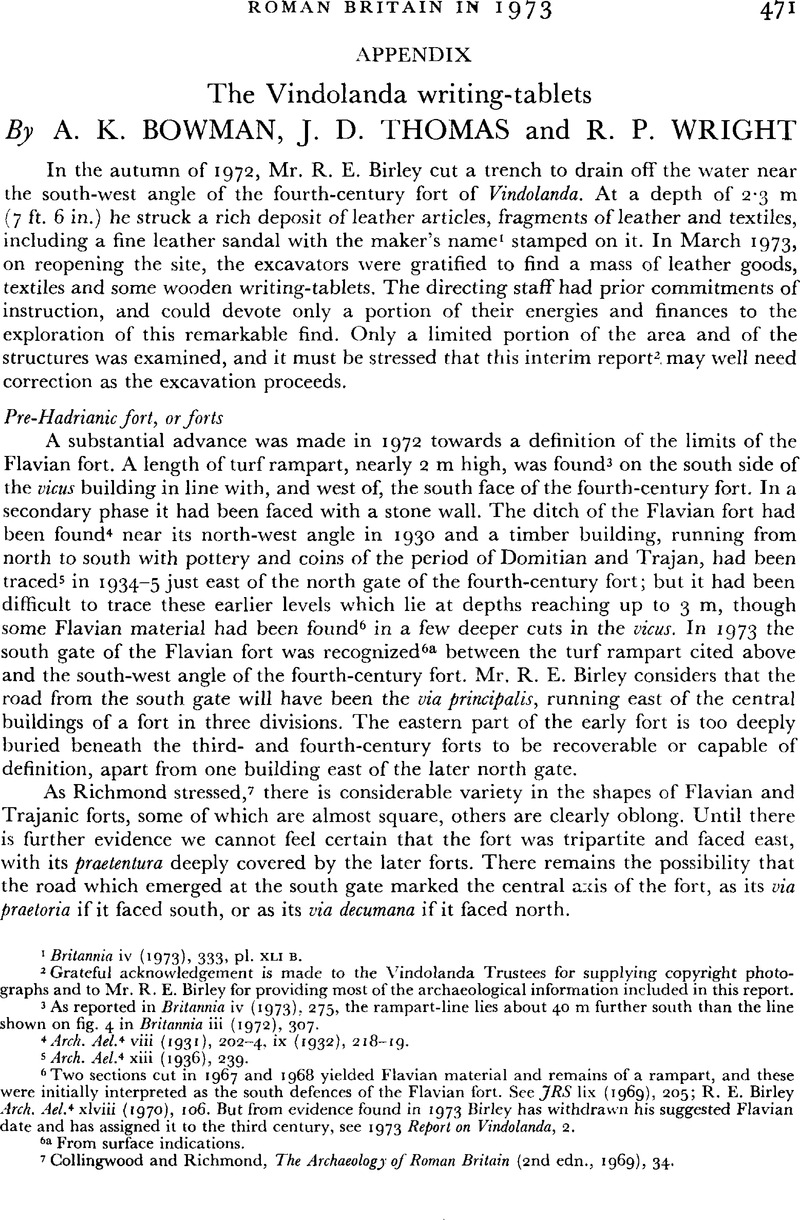Article contents
Appendix: The Vindolanda writing-tablets
Published online by Cambridge University Press: 09 November 2011
Abstract

- Type
- Roman Britain in 1973
- Information
- Copyright
- Copyright © A. K. Bowman, J. D. Thomas and R. P. Wright 1974. Exclusive Licence to Publish: The Society for the Promotion of Roman Studies
References
1 Britannia iv (1973), 333, pl. XLI B.Google Scholar
2 Grateful acknowledgement is made to the Vindolanda Trustees for supplying copyright photographs and to Mr. R. E. Birley for providing most of the archaeological information included in this report.
3 As reported in Britannia iv (1973). 275Google Scholar, the rampart-line lies about 40 m further south than the line shown on fig. 4 in Britannia iii (1972), 307.Google Scholar
4 Arch. Ael. 4 viii (1931), 202–4Google Scholar. ix (1932), 218-19.
5 Arch. Ael. 4 xiii (1936), 239.Google Scholar
6 Two sections cut in 1967 and 1968 yielded Flavian material and remains of a rampart, and these were initially interpreted as the south defences of the Flavian fort. See JRS lix (1969), 205Google Scholar; Birley, R. E.Arch. Ael. 4 xlviii (1970), 106.Google Scholar But from evidence found in 1973 Birley has withdrawn his suggested Flavian date and has assigned it to the third century, see 1973 Report on Vindolanda, 2.
6a From surface indications.
7 Collingwood and Richmond, The Archaeology of Roman Britain (2nd edn., 1969), 34.
8 A duplicated list of the tablets found to date with brief descriptions of their content is in course of preparation. Persons interested in obtaining a copy are invited to get in touch with either Dr. A. K. Bowman, Department of History, University of Manchester, or Dr. J. D. Thomas, Department of Palaeography, University of Durham. It may be necessary to make a small charge to cover cost of postage, etc.
9 Miss A. Rutherford used her special skill and interest in making the primary photographs of the long-drawn sequence, and, after the tablets had been returned from conservation, great patience in regrouping the tablets in a similar sequence for a second round of photographs. In most cases the second pho tographs produced substantially clearer results.
10 Under the direction of Dr. A. E. A. Werner, Mr. W. A. Oddy and Miss Blackshaw treated the material.
11 We are greatly indebted to Dr. John Rea for reading through the transcriptions and notes on the two texts which follow, and for his helpful comments. We wish also to thank Dr. J. N. Adams for his advice on linguistic points.
12 The following abbreviations are employed:
CPL: Corpus Papyrorum Latinarum, ed. R. Cavenaile (1958).
Edict. Diocl.: Diokletians Preisedikt, ed. S. Lauffer (1971).
Holder: A. Holder, Altceltischer Sprachschatz.
RE: Pauly-Wissowa, Real-Encyclopddie.
TLL: Thesaurus Linguae Latinae.
RMR: Fink, R. O., Roman Military Records on Papyrus (American Philol. Ass., Monograph 26, 1971)Google Scholar
- 5
- Cited by


